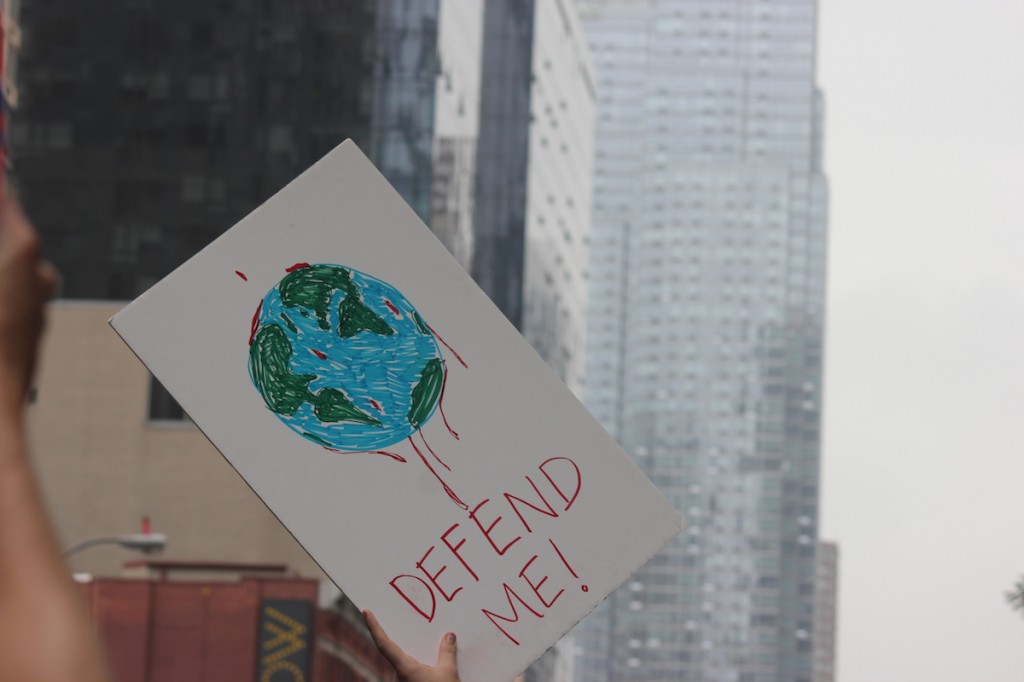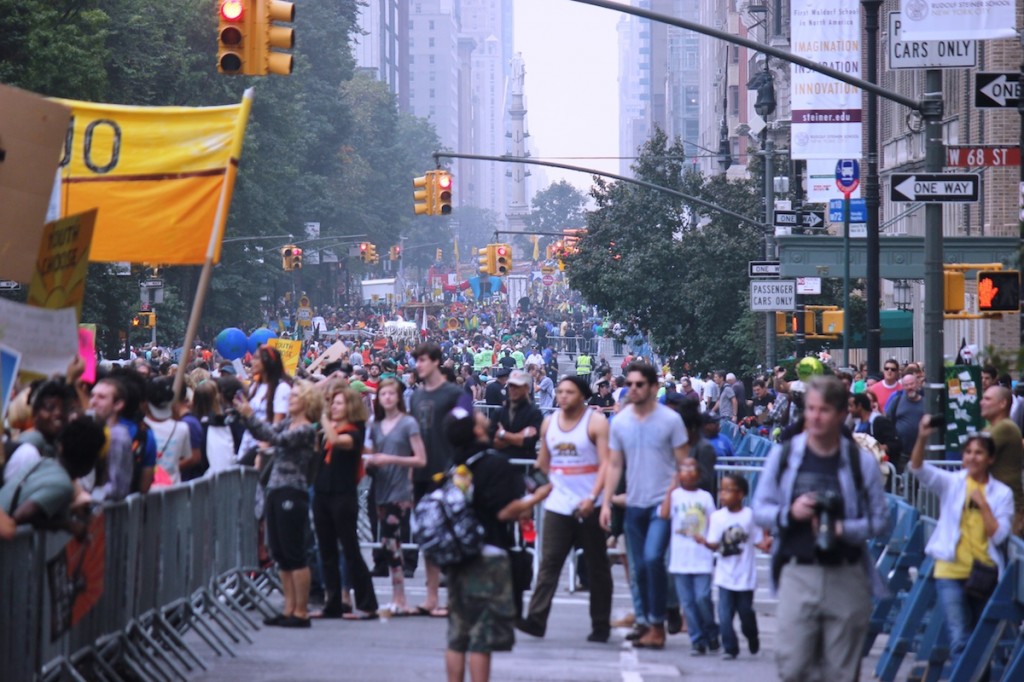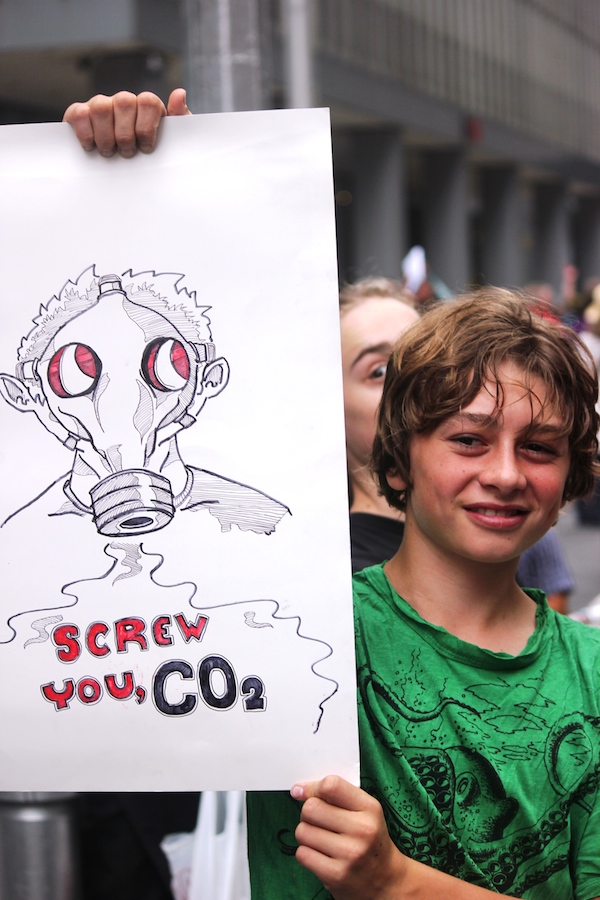
“We don’t want our kids to die!” a throng of students chanted. “We don’t want our kids to die!” They packed the edge of New York’s Central Park West. “We don’t want our kids to die!”
It’s a dire mantra, but it’s not a joke. With the latest National Oceanic and Atmospheric Administration (NOAA) projections setting sea level rise at as high as six feet by 2100, and vastly insubstantial action being taken to combat carbon emissions, it’s not surprising that 400,000 people showed up in New York on Sept. 21 to take action against an increasingly grim future. The People’s Climate March, coordinated with events in 162 countries, was one of the largest environmental demonstrations in history, but it’s not enough. This is a movement that needs to gain ground, and gain ground quickly.
The People’s Climate March was planned to precede the United Nation’s General Assembly, five blocks away. It gained the attention of leaders including Secretary General Ban Ki Moon and President Obama who delivered rousing speeches in the march’s wake, imploring world leaders to listen to its message and unite in implementing drastic, global, economic and infrastructural changes to combat and adapt to climate change.
But talk is cheap, and so far both the U.N. and Obama administration have been all hype and no action. The U.N.’s Kyoto Protocol, which aimed to reduce emissions, expired in 2012 after the 2009 Copenhagen Climate Change Summit disbanded, unsuccessful. Although the Obama administration has made some strides in renewable energy and cutting emissions, it has been chastised by many environmental groups for expanding offshore drill and fracking operations. U.S. policy is still unsustainable.

To understand what policy changes will be needed, it’s important to grasp the costs of inaction, the “business-as-usual” scenario. According to scientists, the answer can be summed up in one word: devastating. On land, worsening droughts and glacial melt will reduce agricultural output and strain water supply for billions of people. Storm patterns will shift and become more intense, leaving other areas inundated. But the bleakest news is coming from research in sea-level rise.
In 2007, the Intergovernmental Panel on Climate Change (IPCC) projected mean sea-level rise of 7-24 inches by 2100. However, many climate experts say those conclusions fail to integrate data on polar ice sheet melting, the key variable in potential rise. Dr. Harold Wanless, chairman of University of Miami’s Geological Sciences department and sea-level rise expert, cites NOAA’s 2012 projections. They include ice-sheet melt and boost the estimate to between 3.9 and 6.6 feet. He estimates rise will be on the higher end of that spectrum and points to intrusions of warm water, which accelerates melting, under the Arctic and Antarctic ice sheets. Less ice means more heat is being absorbed by the ocean, so the process self-intensifies. According to Wanless, the system is “spinning out of control.”
There are two options moving forward. One option is business as usual. The U.S. has the technology and financial means to evade many of the worst effects of climate change while continuing to pollute and waste more than any developed country. Although low-lying cities like Miami will need serious renovation or relocation, technology could help save property, crops and lives, a luxury which the developing world will not have. Even with the strife which will likely ensue in developing countries, America spends more on defense than the next three nations combined, which would provide further buffering.
The second option is change. But hoping for Washington D.C. to lead change is futile. Money buys votes there, and the fossil fuel industry has a $65 million lobby. The idea of “top-down [change] is nonsense,” claims Dr. Richard Weisskoff, professor and International Studies department chair. It comes down to the people. It’s our choice. As Weisskoff puts it, we’re in a “crisis of spiritual direction,” between indifference and accountability.
Dr. John Van Leer, sustainability professor and seasoned protester, agrees that the most effective catalyst of change is popular movement. He points to the first Earth Day demonstration in 1970 which led to the Environmental Protection Agency’s creation by President Nixon. In these movements, “it comes down to the willingness of people to go into the streets.”

The People’s Climate March enacted that ideal, hoisting the motto “To change everything, we need everyone,” because that’s true. So get your heads out of your books and join history. Students have the energy and the power to drive a movement. They did during the Civil Rights Movement in the ‘60s. About 50,000 college students attended the People’s Climate March, according to the official website.
Today, a movement is brewing. The roots are being established on campuses around the country and being linked through larger organizations including 350.org, the Sierra Club and Greenpeace. At UM, Earth Alert is the club to go to regarding environmental action. Also, there is an online petition with the aim of petitioning President Donna E. Shalala to divest the school’s funds from fossil fuels – a strategy which helped end South Africa’s apartheid.
Climate is changing now. Now is not the time to wait. Now is not a time to react. Now there is a choice. Now is your choice. Now is our choice.
Nick Sirio is a junior majoring in creative writing.






